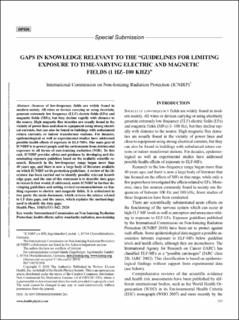Gaps in Knowledge Relevant to the “Guidelines for Limiting Exposure to Time-Varying Electric and Magnetic Fields (1 Hz–100 kHz)”
| dc.contributor.author | Marino, Carmela | |
| dc.contributor.author | Croft, Rodney | |
| dc.contributor.author | Feychting, Maria | |
| dc.contributor.author | Green, Adele C | |
| dc.contributor.author | Hirata, Akimasa | |
| dc.contributor.author | d'Inzeo, Guglielmo | |
| dc.contributor.author | Oftedal, Gunnhild | |
| dc.contributor.author | Okuno, Tsutomu | |
| dc.contributor.author | Röösli, Martin | |
| dc.contributor.author | Sienkiewicz, Zenon | |
| dc.contributor.author | van Rongen, Eric | |
| dc.contributor.author | Watanabe, Soichi | |
| dc.contributor.author | Lagroye, Isabelle | |
| dc.contributor.author | Karipidis, Ken | |
| dc.contributor.author | Mattsson, Mats-Olof | |
| dc.contributor.author | Woods, Andrew | |
| dc.date.accessioned | 2021-09-07T08:21:04Z | |
| dc.date.available | 2021-09-07T08:21:04Z | |
| dc.date.created | 2021-01-18T09:07:07Z | |
| dc.date.issued | 2020 | |
| dc.identifier.issn | 0017-9078 | |
| dc.identifier.uri | https://hdl.handle.net/11250/2773913 | |
| dc.description.abstract | Sources of low-frequency fields are widely found in modern society. All wires or devices carrying or using electricity generate extremely low frequency (ELF) electric fields (EFs) and magnetic fields (MFs), but they decline rapidly with distance to the source. High magnetic flux densities are usually found in the vicinity of power lines and close to equipment using strong electrical currents, but can also be found in buildings with unbalanced return currents, or indoor transformer stations. For decades, epidemiological as well as experimental studies have addressed possible health effects of exposure to ELF-MFs. The main goal of ICNIRP is to protect people and the environment from detrimental exposure to all forms of non-ionizing radiation (NIR). To this end, ICNIRP provides advice and guidance by developing and disseminating exposure guidelines based on the available scientific research. Research in the low-frequency range began more than 40 years ago, and there is now a large body of literature available on which ICNIRP set its protection guidelines. A review of the literature has been carried out to identify possible relevant knowledge gaps, and the aim of this statement is to describe data gaps in research that would, if addressed, assist ICNIRP in further developing guidelines and setting revised recommendations on limiting exposure to electric and magnetic fields. It is articulated in two parts: the main document, which reviews the science related to LF data gaps, and the annex, which explains the methodology used to identify the data gaps. | en_US |
| dc.language.iso | eng | en_US |
| dc.publisher | Lippincott, Williams & Wilkins | en_US |
| dc.rights | Attribution-NonCommercial-NoDerivatives 4.0 Internasjonal | * |
| dc.rights.uri | http://creativecommons.org/licenses/by-nc-nd/4.0/deed.no | * |
| dc.title | Gaps in Knowledge Relevant to the “Guidelines for Limiting Exposure to Time-Varying Electric and Magnetic Fields (1 Hz–100 kHz)” | en_US |
| dc.type | Peer reviewed | en_US |
| dc.type | Journal article | en_US |
| dc.description.version | publishedVersion | en_US |
| dc.source.journal | Health Physics | en_US |
| dc.identifier.doi | http://dx.doi.org/10.1097/HP.0000000000001261 | |
| dc.identifier.cristin | 1872820 | |
| cristin.ispublished | true | |
| cristin.fulltext | original | |
| cristin.qualitycode | 1 |

